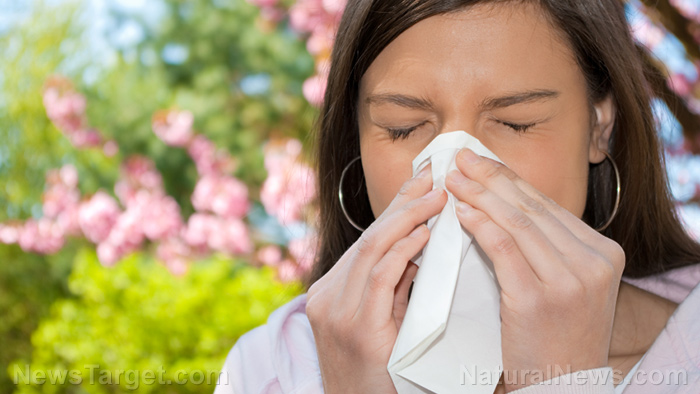UK scientists warn that household aerosols are worse pollutants than vehicles
05/12/2021 / By Ramon Tomey

A new British study has found that household aerosols release more harmful volatile organic compounds (VOCs) than all vehicles in the U.K. VOCs are a large group of chemicals which are released into the atmosphere by cooking, burning fuel and using cleaning and beauty products. Thus, experts have called for a shift away from these aerosols to more environmentally-friendly alternatives.
The April 22 study published in Elementa provided global estimates of VOCs from aerosols based on a wide range of different sources. It also named products that could potentially emit the highest amount of VOCs. The researchers remarked that carpet cleaners, windshield de-icers and oven cleaners were most likely to fall under this category.
Study author and chemistry professor Alistair Lewis of the University of York told the Daily Mail: “In some countries like the U.K., we have reports from manufacturer associations that give sales figures, and then emissions data that go to government and international environmental reporting. We then combine that with laboratory data to turn sales into tons of emissions.”
Household aerosols usually take the form of deodorants and body sprays. Aside from personal care products – they also come as hairsprays, air fresheners, wood polish, insecticides and oven cleaners. However, exposure to certain VOCs has been linked to long-term chronic health effects such as liver and kidney damage, lung conditions and nerve problems. These compounds also combine with nitrogen oxides in the presence of sunlight, creating smog. Aside from harming human health, the resulting smog also damages crops and plants.
According to the paper, aerosols constituted 6.1 percent of VOC emissions from humans in 2017. This reflected a two percent increase from 1990 figures. The study noted that this amount comprised twice the VOC emissions from passenger vehicles in the U.K. running on gasoline.
The world’s population now uses huge numbers of disposable aerosols, amounting to more than 25 billion cans every year. People in high-income countries use an average of 10 cans per person on a yearly basis. Personal care products such as deodorants, body sprays and antiperspirant sprays make up a large portion of this use.
But with people from lower- and middle-income economies purchasing these aerosols, a surge in the amount of emitted aerosols is projected. This is estimated to cause the release of more than 1.3 million tons of VOCs every year. To make matters worse, the study projected that this could rise to 2.2 million tons by 2050.
The researchers exhorted the use of non-aerosolized versions for some household products
VOCs currently being used in aerosolized household products cause less damage than the chlorofluorocarbons (CFCs) they replaced. CFCs damage the Earth’s ozone layer which shields the planet from the sun’s harmful ultraviolet rays. The Montreal Protocol to phase out CFCs was agreed upon in 1987 to respond to this issue. (Related: Earth’s ozone hole rapidly shrinking following ban of ozone depleting chemicals.)
But no one in the 1980s foresaw the rise in aerosol product consumption worldwide. At present, VOCs constitute about 93 percent of current aerosol emissions by mass. Compressed air and fluorocarbons contribute smaller amounts – at 6.6 percent and 0.4 percent, respectively.
According to the study, a number of products have non-aerosol alternatives that can be used in either liquid or solid form. These include roll-on deodorant, hair gel, solid furniture polish, tanning spray and air fresheners. “Virtually all aerosol-based consumer products can be delivered in non-aerosol form,” Lewis remarked. (Related: Study reveals people using toxic personal care products are the “greatest pollutants” of office air.)
The study by Lewis and his colleague, professor Amber Yeoman, noted that the persistent use of aerosol products despite the existence of non-aerosol counterparts shows “the continuation of past consumer preferences and habits. Thus, their paper suggested a “communications-led” approach that either encouraged people to moderate consumption of aerosols – if not switch to non-aerosol products entirely.
They also noted that the role of aerosol VOCs in air pollution needs to be much more clearly articulated. “The association of VOC emissions with gasoline and vehicles is heavily entrenched, and even among air quality professionals – there is limited knowledge of the scale of aerosol impact,” they noted.
Given this problem, Lewis suggested: “Labeling of consumer products as high VOC-emitting – and clearly linking this to poor indoor and outdoor air quality – may drive change away from aerosols to their alternatives.” He noted that such a tactic has been successful for products such as paints and varnishes.
The chemistry professor ultimately commented: “Making just small changes in what we buy could have a major impact on both outdoor and indoor air quality, and have relatively little impact on out lives.”
Visit Pollution.news to read more about VOCs and other polluting substances found in household products.
Sources include:
Tagged Under: aerosol emissions, aerosol products, chlorofluorocarbons, household aerosols, household chemicals, Montreal Protocol, non-aerosol versions, ozone layer, Personal care products, vehicle emissions, volatile organic compounds
RECENT NEWS & ARTICLES
COPYRIGHT © 2017 TOXINS NEWS





















